Why Dual Red Peaks in Grow Lights Are Nonsense
Not a new idea. Not useful. Just bad engineering and worse marketing.
There’s a trend spreading through grow light marketing that needs to die.
It’s the idea that combining 640 nm and 660 nm diodes on the same board — usually under the label of “dual red peaks” — somehow improves growth, terpene expression, or spectral balance.
It’s everywhere now. Companies are slapping extra red chips onto fixtures that didn’t need them, calling it “spectrum innovation,” and charging a premium for it. Some even throw in buzzwords like “terpene boost” or “enhanced photomorphogenesis” to dress it up like science.
Let’s be crystal clear.
This is not innovation.
It’s not clever spectrum design.
It’s duplicated output sold as a feature.
And it’s nonsense.
The Claim
“Combining 640 nm and 660 nm gives broader red coverage for photosynthesis and terpene production.”
Reality check:
You already have that coverage.
Not “sort of.” Not “kind of.”
You already have it — because 640 nm is dominant in every proper 660 nm diode.
Exhibit A: Osram GH CSSRM4.24 — The Truth in the Datasheet
Here’s Osram’s GH CSSRM4.24. It’s one of the most respected horticultural deep reds on the market:
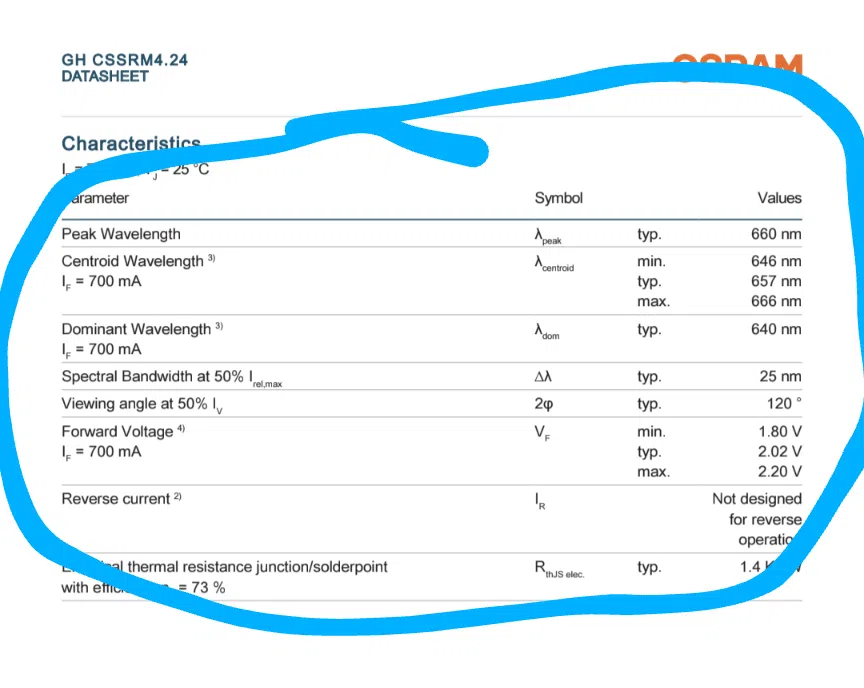
- Peak Wavelength: 660 nm
- Dominant Wavelength: 640 nm
- Spectral Width (FWHM): 25 nm
- Emission Range: 628–675 nm
Read that again — the dominant wavelength is 640 nm.
This diode doesn’t just touch 640. It emphasizes it.
It’s labeled 660 nm because that’s the peak, but the output curve puts more total energy in the 640 nm zone than anywhere else.
If you’re adding 640 nm diodes to “fill in the red spectrum,” you’re literally stacking more of what’s already the strongest part of the emission.
You’re not improving anything.
You’re doubling down on something that’s already dominant.
Exhibit B: Everfine Sphere Test — Same Story, Different Diode
Here’s a full lab-grade integrating sphere report for another high-quality 660 nm diode — arguably better binned than the Osram diode above:
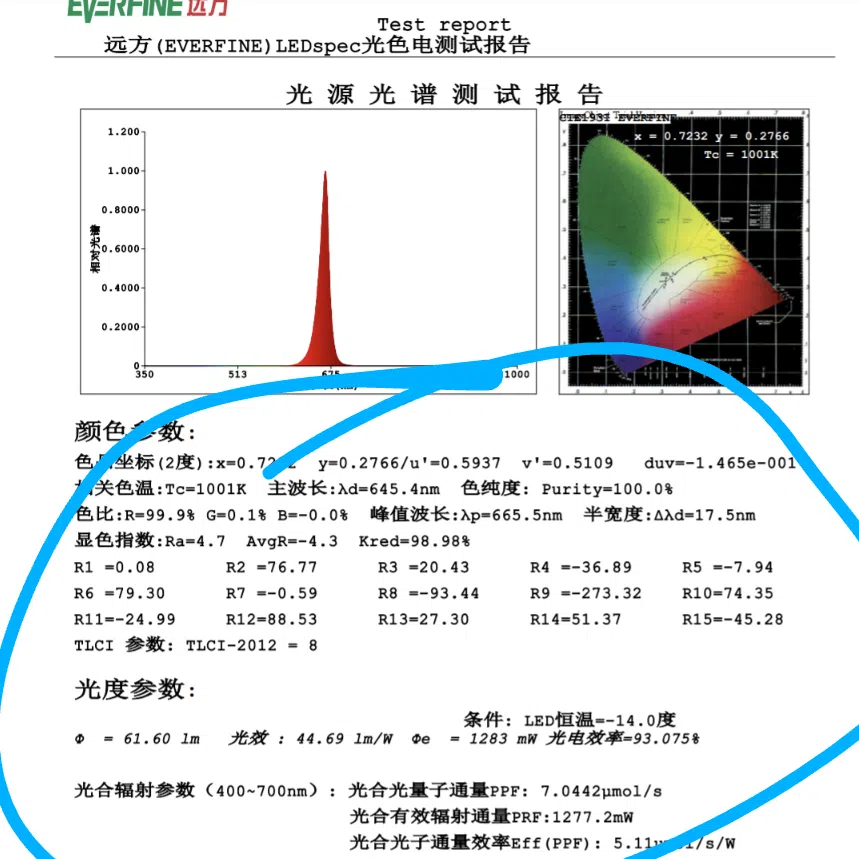
- Peak Wavelength: 665.5 nm
- Dominant Wavelength: 645.4 nm
- FWHM: 17.5 nm
- PPF: 7.044 µmol/s
- PPE: 5.11 µmol/J
Again: dominant output is squarely in the 640s.
Not a side effect. Not a coincidence.
That’s how these diodes are designed.
So now you have two different manufacturers, two different test systems, and the same exact result — the 640s are already being hammered.
There is zero reason to add more.
Why Dual Red Peaks Make No Technical Sense
Let’s break it down.
If your fixture already has good 660 nm diodes, then:
- You already have strong 640 nm output.
- You already have full red-band coverage.
- You already have the dominant wavelength sitting at 640–645 nm.
Adding dedicated 640 nm diodes does not:
- Improve yield
- Improve terpene expression
- Add spectral coverage
- “Balance” anything
It only adds cost, heat, and confusion — and creates a meaningless double bump on a spec sheet that looks good to people who’ve never read a datasheet.
Final Word
This isn’t up for debate.
The 640 nm band is already the strongest part of the emission from modern 660 nm diodes. It is the dominant wavelength, not the missing one.
There is nothing to “boost.”
And if a company is calling 640 nm a “terpene enhancer” or trying to sell it as critical spectrum coverage — they either don’t understand their own hardware, or they’re hoping you don’t.
Dual red peaks don’t offer more performance.
They don’t unlock new plant responses.
They just pad the BOM and make you think you’re buying something special.
One proper 660 nm diode already handles the job.
You don’t need a second red to do what it’s already doing better.
Want proof? Just look at the spectral curve of a real 660 nm diode.
The 640s are already maxed out. There’s nothing left to “supplement.”
What About the 2024 Study Everyone Likes to Reference?
Some folks are quick to cite the 2024 Frontiers in Plant Science paper that compared narrow 660 nm red to a “dual-peak” 640 + 660 mix in cannabis. On paper, it showed a small bump in yield and terpene expression under dual-peak red.
Here’s the part they leave out.
First Problem: They Built a Fake 660 scenario that no modern horticulture light uses.
The Red 660 treatment in this study was characterized by a narrow-band red light, with a peak at 660 nm and no or minimal spectral contribution from lower red wavelengths such as 640 nm. ALSO NOTICE HOW MUCH DIFFERENT THE R:FR IS ON THE BROADSPEC!!! We ALREADY KNOW that TO MUCH Far Red IS BAD IN FLOWER IF CONTINUISLY USED!!! IT IS NOT THE SAME AS THE OTHER 3 CONTROLLS!!!
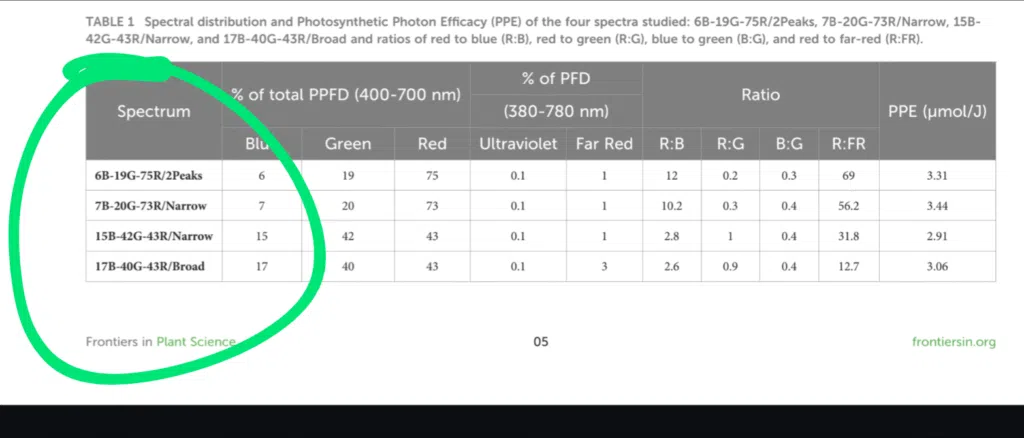
That 660 isn’t real.
It’s a hyper-isolated lab spike with all the 640 stripped out. Any modern horticultural 660 — Osram, LEDStar, Sanan, Samsung, and pretty much all the rest— already floods the 640s. What they tested wasn’t a real-world baseline. It was a nerfed red spectrum designed to make 640 nm look necessary. This wasn’t just a red test — it was broad spec + extra far-red vs. nerfed 660 red (narrow band) vs narrow band 660 + narrow band 640 with inconsistent blue ratios and far red ratios throughout.
It Only Helped Under Weak Lighting
Photosynthetic quantum yield only improved under low light intensity… No difference at high light intensity. Notice how the increase is from Leaf and Stem Weight, not what we are after
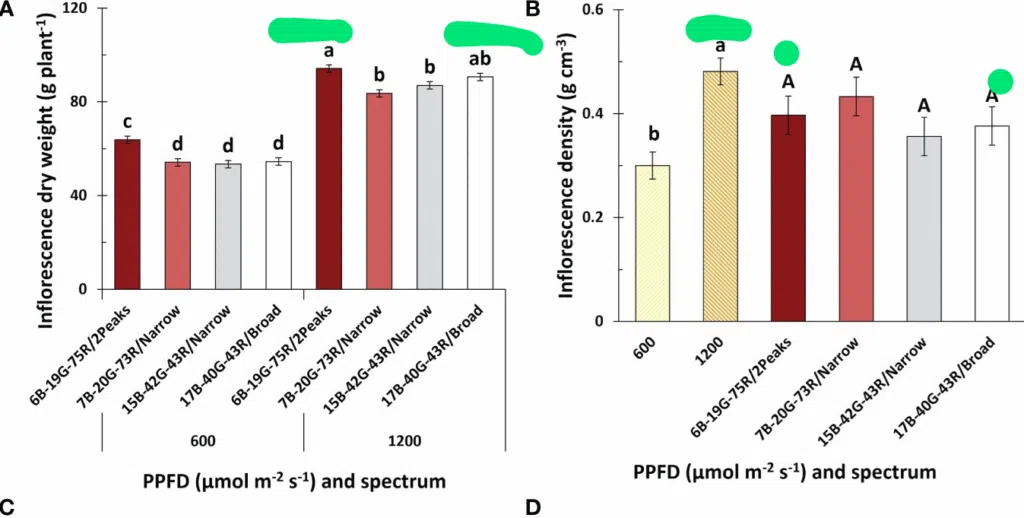
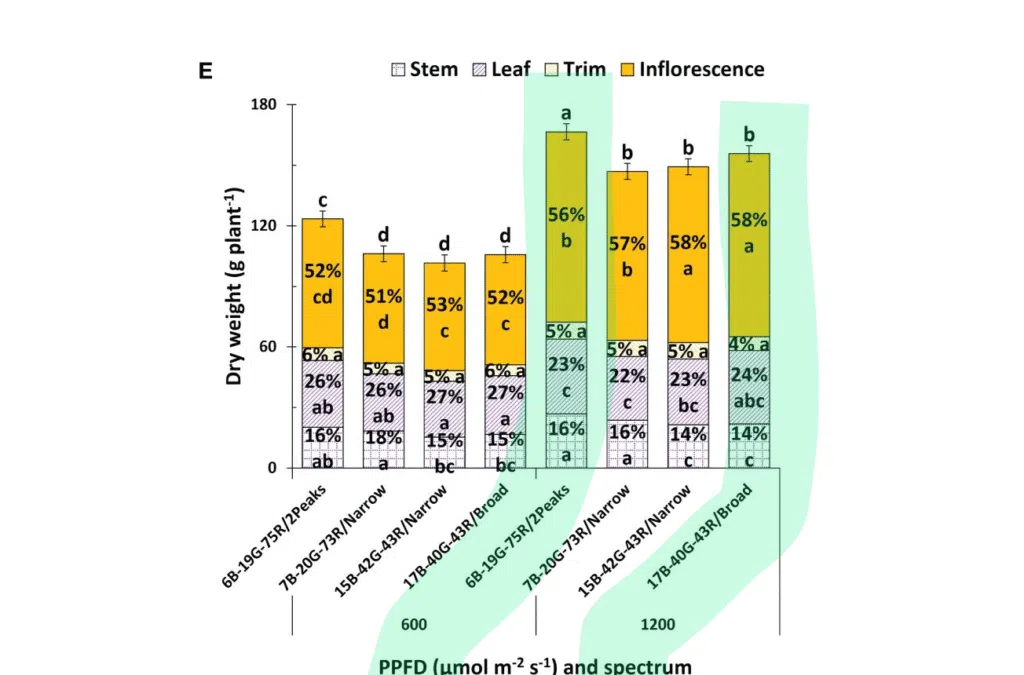
Exactly what you’d expect from a test like this.
The so-called benefit only showed up at low PPFD — the kind no serious grower is running in flower. At real flower intensities (800–1200+ PPFD), there was no gain at all.
No Cannabinoid Boost, Weak Terp Shifts
No differences in cannabinoid concentration were observed… Minor effects on specific monoterpenes and sesquiterpenes…
Inflorescence yield improved under the dual-peak red treatment (P = 0.10) and considering they were flowered in the 80’s instead of low 70’s like they should have been, and who even knows how they were dried this is far from representative of a real world application
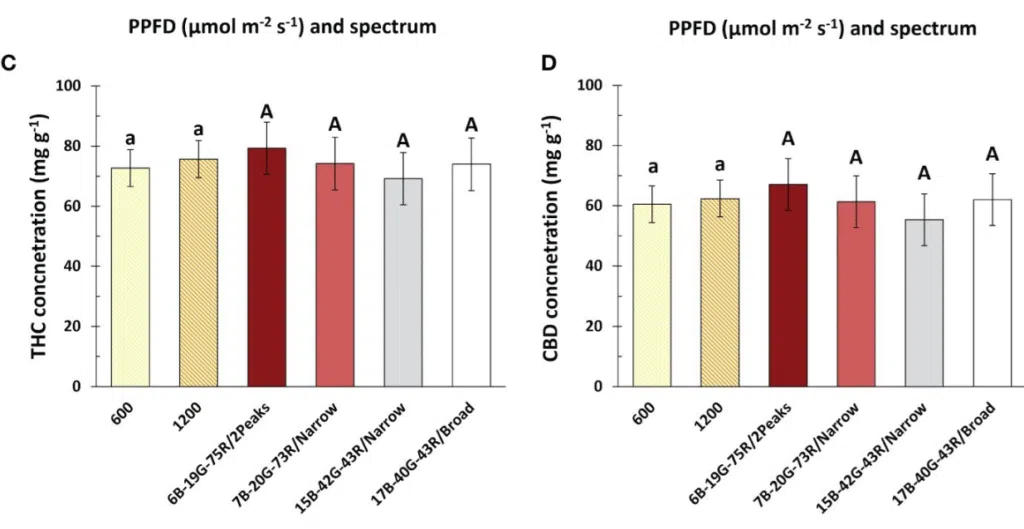
P = 0.10 isn’t statistical confidence — it’s just barely suggestive. (P = 0.10, which falls short of the conventional α = 0.05…)
There was no cannabinoid increase. Terpene changes were tiny and conditional. And the slight yield bump? That was linked to a looser plant structure that captured light better — not red spectrum chemistry.
Even the Study Admits It’s Not Real-World
That’s the quiet part.
They admit the test doesn’t apply to actual LED fixtures. Proper 660 nm diodes already dump energy into the 640s. The only reason dual-peak showed an effect here is because they created an artificial gap using narrow band 660’s and then filled it in with 640’s.
That’s not proof of benefit. That’s proof their “single red” was broken to begin with.
Bottom Line
This study doesn’t contradict anything here — it confirms it.
If you cripple a red spectrum by removing most of the 640 content, then yeah, adding it back in will help. But that’s not how real fixtures are built. Real 660s for horticulture already hammer the 640 band.
You’re not adding anything. You’re duplicating what’s already dominant.
Dual red peaks don’t deliver more yield.
They don’t improve cannabinoids.
They don’t “unlock” better terpene profiles at high intensity.
They just solve a problem that doesn’t exist — unless you built the light wrong in the first place.

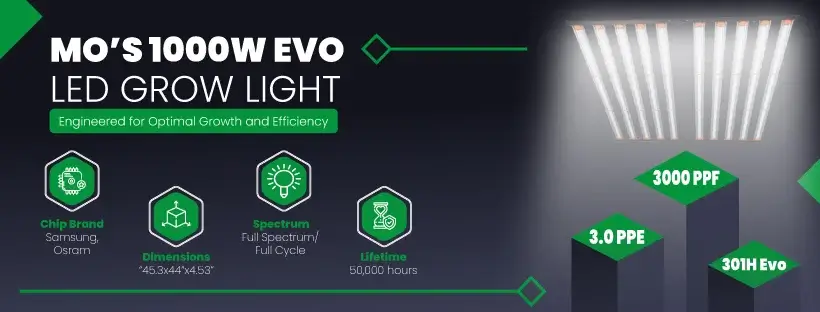
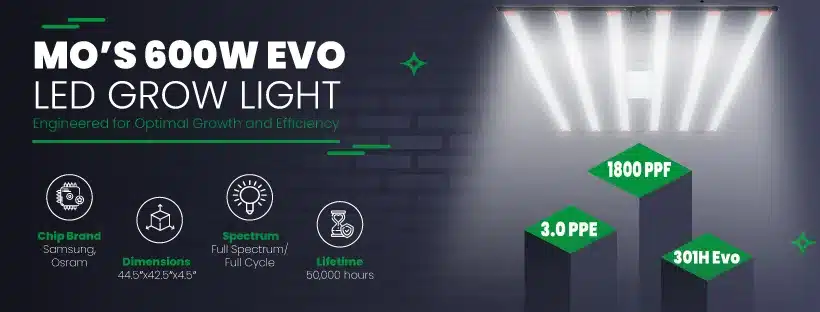
Leave a Reply